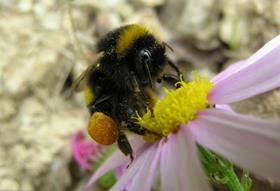
Due to a range of circumstances, the pollination of cherries is becoming increasingly complex. Bumblebees provide the best results and Biobest supplies them in highly practical hives resistant to all kinds of weather conditions.
As weather conditions become increasingly variable, many cherry producers are turning to covers to protect from frost and heavy rain while the cherries are in bloom.
However, protective covers have one disadvantage, which is to disorient honeybees, causing them to fly out less frequently and resulting in disappointing levels of pollination.
According to biological control specialist Biobest, bumblebees experience far fewer problems, being better protected against cold, rain and heat.
Instead of cardboard hives, Biobest supplies bumblebees for the company’s Multi-Hives, which are resistant to all weather conditions, including precipitation, heat and cold.
“Our Multi-Hives are constructed from material that can withstand the rain and is also insulated against cold and heat,” explains Biobest’s Jurgen Bouveroux.
“In frosty weather, the bumblebees will encounter little or no adverse effects,” he said. “In contrast, bumblebees in cardboard hives may have to deal with extreme low temperatures at night. That demands a great deal of energy and means they will be less apt to fly out of the nest. Moreover, if the cold persists, they simply refuse to work.'
Nor are unseasonably warm temperatures an issue with Biobest’s Multi-Hives, which maintain a pleasant temperature, guaranteeing much more activity from the bees. “This makes our product unique when compared to all the others on the market,” said Bouveroux.
The company’s Multi-Hives, which are both reusable and recyclable, have been specially designed for use on outdoor crops, with growers advised to order them well in advance of the start of the flowering period.
Each Multi-Hive contains three separate colonies of ‘bombus terrestris’, containing more than 350 bumblebees in total, providing pollination for four to six weeks.



